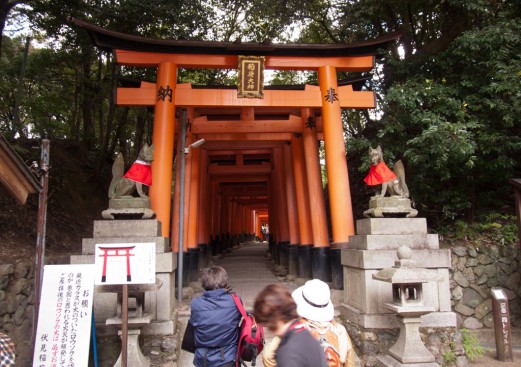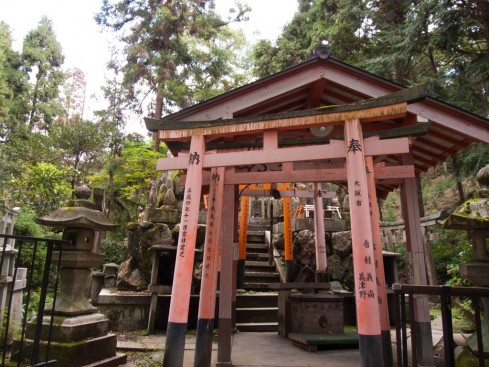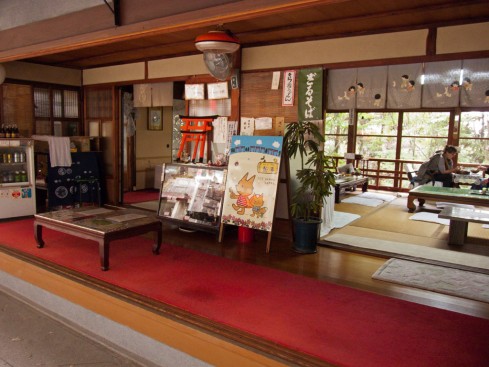October 26, 2011
I don’t know how many shrines to Inari the fox god I have seen. It sometimes seems that every Japanese town worthy of the name has one. Usually they can be easily identified by a row of red torii, instead of just having one at the entrance.
However the Fushimi-Inari Shrine, located just two stops from the Kyoto train station, is something else entirely. This is the boss of them all, the head office to which all the other Inari shrines report.

Walk through the torii at the entrance and you will eventually reach the main gate. Though it has appropriate colors for a Shinto shrine it resembles the gate of a traditional Buddhist temple in that it has gate guardians.

But as with the Konpira Shrine the guardians look like human warriors.

Inside the gate is a large courtyard.

The shrine seemed unusually busy for a weekday afternoon. Some sort of elaborate ritual was being performed in this building. A uniformed security guard watched carefully to make sure that nobody took any photographs.

A small building just to the right housed a stage with koto players performing in traditional dress. Once again the security guard made sure that there were no photos.
I think this is an administration building but I’m not sure. A couple of mikos quickly shooed me out when I looked inside.

Incidentally, one might well ask “Why make all this fuss about a fox god? Aren’t foxes usually magical mischief-makers in Japanese folklore?”
This is the explanation I’ve been given:
- Rice farmers hate sparrows.
- Foxes kill sparrows.
- Therefore Inari is the god who protects the rice harvest–and by extension the entire economy of Japan.
I’m not sure that I buy this. Wouldn’t a cat god be more effective? But then I’m not a rice farmer, so what do I know?
Officially I think Inari is not supposed to be a fox. Inari is an invisible spirit and foxes are his messengers. However that’s not necessarily the way that the word “Inari” is used in popular culture.
You might have noticed items on a Japanese restaurant menu containing the term “Inari,” e.g. “Inari Udon.” This means that the dish contains fried tofu. Supposedly foxes just loooove fried tofu. (I have no reason to doubt this.)
In any case the main attraction is not in this courtyard. To see it go through this torii…

…to reach what this shrine is really famous for:

a long path lined with thousands of torii.

The path splits in two after a while, which allowed me to get ahead of the gang of middle-schoolers.

Both paths soon emerge into a small courtyard.

Here is a popular diversion: a pair of “Heavy Light Stones.” Toss a coin into the box, make a wish and pick up one of the round stones. If it feels light then your wish will be granted; if it feels heavy it won’t be.

I had to try this out, so I made a pro forma wish for world peace. The stone felt…moderately heavy.
However we are far from done. The path continues to the left.

At various points along the path there are mini-shrines off to the side.

Here the path was blocked by some workmen so I was forced to take a detour.

Is it my imagination, or is the path getting steeper?

It’s not my imagination. The path runs up the side of the aptly named Mt. Inari.

A convenient shop selling snacks and souvenirs.

This was starting to seem a lot like the Konpira Shrine, but once again my innate stubbornness kept me going, determined to find out what was at the top.

Finally my patience was rewarded.

The top shrine, filled with foxes and little torii.

This really wasn’t as long a trek as Konpira. The path is supposed to be 4 km. long and lined with over 10,000 torii, but given the number of side-paths that I didn’t explore, I’m sure I covered a much shorter distance.











